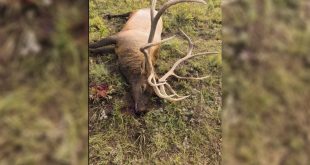Are Wyoming Whitetails Local Favorites?
Jaden Bales
What do Wyoming locals regard as nuisances, nonresidents generally do not apply for, and wildlife managers have a hard time providing access for? If you guessed Wyoming’s burgeoning whitetail population, you would be correct.
For a state with traditionally very limited rut hunting opportunities on mule deer, whitetail deer hunters in Wyoming who score a Type 3 deer license can hunt whitetails the entire month of November, with some seasons starting as early as October 1st and ending December 31st with a rifle, and including September 1-30 archery dates. This is also often the case with the reduced-price Type 8 whitetail antlerless licenses that are available to keep the doe and fawn whitetail populations in check if hunters can get access to them.
Type 3 whitetail licenses are the full-priced deer licenses Wyoming uses to unlock “any” whitetail opportunities (read: buck hunts). In Wyoming, it is both legal and possible to hold a whitetail buck license, as well as a mule deer buck license in the same year. If lucky enough to pick up a leftover Type 3 after drawing a Type 3 license in the initial draw, an eager whitetail hunter could take two whitetail bucks in a single season if they chose to do so.
When many of these licenses were initiated, there was a delay in information to the general hunting public, likely coupled with a lack of interest in chasing whitetails when you can hunt mule deer every year or two as either a resident or nonresident.
However, with a steady decline in mule deer population has come both lower expectations on the mule deer front across the West and in Wyoming. Coupled with better information and increasing licenses for these whitetail opportunities, and for many Wyoming residents these whitetail licenses are getting tough to come by. A decade ago, the Type 3 whitetail license near me was easily snagged as a first choice, and possibly as a second choice option. Today, drawing odds in the initial draw hover at 50% year-to-year. Of course, the drawing gods have not been kind to my application for the last three years.
This decrease in the ability for Wyoming residents to snag a whitetail Type 3 tag is a common trend in areas with relatively good public access and landowner interest to hunt these whitetail buck populations.
Just 10 years ago, only 2,244 Wyoming residents were applying for Type 3 whitetail licenses as their first choice. In 2023, 4,665 residents put a whitetail buck tag as their first choice, more than double the interest as a first choice option.
One can speculate why the resident interest in Type 3 licenses is peaking with the two camps of people who put them down as their first choice; mule deer hunters and non-mule deer hunters.
That may seem obvious, but for someone like myself who has General season mule deer hunting haunts, I am not interested in giving up hard-earned year-to-year scouting and hunting information for a chance at a different mule deer tag in Wyoming. Instead, I opt for my local whitetail Type 3 license as my first choice because I know I can ask for permission when I run into landowners at the local diner or during cattle brandings later this spring. Then, I can enjoy sitting for a whitetail before and after work.
The other kind of whitetail hunters putting Type 3 down as their first choice are the ones who are discouraged by the state of mule deer hunting and want to focus on the more prolific deer species. As General license sales continue to decline across Wyoming, with the massive increase in Type 3 license interest, it is safe to assume there is a good amount of switching to take advantage of the long season dates and high success if you can turn up access.
While some of this exists in the nonresident pool, the vast majority of Type 3 licenses are available with zero preference points. My best friend from Hawaii was able to take a nice 10-point (eastern scoring) whitetail on land I have access to in 2022 because of this.
Chasing a Wyoming whitetail probably is not on too many folks’ radar. Still, given the expansion of the species across the state, and the increasingly tighter belt wrapped around nonresident hunting opportunity, it may be worth understanding how the Cowboy State allocates hunting opportunities for these cover-bound deer.
 Eastmans' Official Blog | Mule Deer, Antelope, Elk Hunting and Bowhunting Magazine | Eastmans' Hunting Journals
Eastmans' Official Blog | Mule Deer, Antelope, Elk Hunting and Bowhunting Magazine | Eastmans' Hunting Journals




